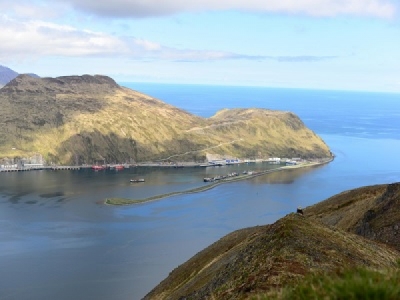
Posted on October 24, 2018
In 1995, the U.S. Army Corps of Engineers did a study that identified the entrance channel as a potential dredging project. You know, the pollock fishery was soundly going at that point — and the containerized cargo. Delta Western had fuel tankers and all those things going on. And it really didn’t slow down. So roughly in the 2010-2011 realm, some of the industry started indicating, ‘Our ships are getting old. We’re going to be bringing in bigger ships.’ That mean we couldn’t get them over the bar. The bar today is about 43 feet.
KUCB: And is that 43 feet deep?
PM: 43 feet deep. And we claim that we’re a deep-draft port. But truly, “deep draft” means 45 feet or greater. So the port might be deep-draft, but you’re not going to get a deep-draft vessel in. So we started pushing these buttons with the Corps of Engineers. We hired a consultant to get it back on the Corps’ radar and say, ‘Hey, we believe there’s still some very strong economic benefits to doing this.”
KUCB: That was about three years ago. The Corps did agree to take a fresh look at the feasibility of dredging. In that time, what have they been studying exactly? And what are they going to present now?
PM: They’ve been going through all the economic benefits, the environmental impacts, the engineering. They’ve looked at marine life on the seafloor bed. They’ve looked at mammals in the area. They’ve identified a potential site for dumping the dredging material. And this Tuesday, Wednesday, and Thursday, the Corps of Engineers is bringing out a team to present the draft feasibility study. This is a really important milestone in terms of how the feasibility works into actually dredging. This doesn’t mean that we’re actually going to dredge.
KUCB: You’ve said that final decision will come in February, when we’re also likely to learn more about the cost.
PM: And at that point, it’s all about whether they can fund a project on the federal level. But they’ll make a recommendation as to what this project may or may not qualify for. And at that point, the City Council has the opportunity to say, ‘Yeah, we’re on board with this’ or ‘This isn’t for us. This isn’t the right timing.’
KUCB: If those discussions are supposed to play out in February and beyond, what are we expecting to learn this week?
PM: We should have a much better understanding of what their intentions are. For part of the study, we sent two of our Alaska marine pilots down to do simulation work, and they spent a tremendous amount of time. Because every foot of water that we go deeper means something to the industry for the ability to navigate vessels. And we’ve bounced back and forth between 60 and 50 [feet deep], and I think we’re settling somewhere in the 58 range. We don’t know for sure what their recommendation is going to be, but that’s one piece of information that will come out in discussions of this feasibility study.
KUCB: Beyond that very important number, what else are you eager to see from their study?
PM: I’ll be really interested to understand their determinations on the — or no impacts — on Front Beach. What it means for currents. What it means for whatever you dredge, [because] there’s always the potential of that filling back in. Those are the things that I want to learn. Because it’s like, ‘OK. This has great economic benefit for us.’ Does it have any economic downturns? Are we going to end up with extra erosion control on Front Beach? Or long-term maintenance requirements for keeping [the channel] open?
Source: KUCB





